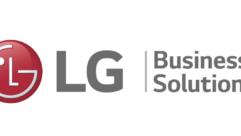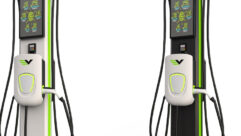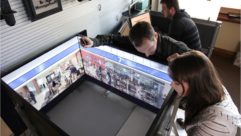
Picture This: The Content of Digital Signage
Apr 1, 2006 12:00 PM,
By Jeff Sauer
The key to lifelike images lies in improved grayscale performance.
Over the past few months, Sound & Video Contractor has reviewed a few relatively simple digital signage solutions (including Chyron’s ChyTV, Focus Enhancements’ FireFly, and Samsung’s MagicNet 460pn panel) that can handle much, if not all, of what a smaller digital signage installation might require. Products like Inscriber’s InfoCaster 2.0 (reviewed on p. 78) can often handle those smaller installations too, and with plenty of features, but more often, they are designed to scale up to larger digital signage infrastructures of dozens or even hundreds of displays.
A QUESTION OF SCALE
Naturally, the more expensive InfoCaster system offers a lot more layout, animation, and creative control compared to ChyTV or FireFly. Yet, there are more basic differences. ChyTV and FireFly are hardware devices that connect directly to the digital sign monitor, as are other freestanding devices like Adtec Digital’s edje and Soloist, Canopus’ MediaEdge 2, and ElectroSonic’s FrEND. On the other hand, InfoCaster — as well as systems from companies like Scala and Mercury Online — is a software-based system that connects to the digital sign via a local general-purpose computer running a software player. Ironically, it’s the dedicated hardware devices that operate more autonomously than the general-purpose computers in digital signage infrastructures.
Many hardware devices can be configured to automatically receive new content files and playlist schedules from a remote server, and some can even poll the server during nighttime or off-use hours. However, with the exception of those data transfers, the individual hardware devices are designed to operate with little or no interaction with a server. They run scheduled playlists, display content, and generally maintain log files.
InfoCaster and the other software-based products tend to have a more server-terminal approach, with the server (the Network Manager in the case of InfoCaster) maintaining and distributing the playlist schedule to each of the Player computers in the system. That allows for more centralized system administration and oversight. For example, InfoCaster’s Network Manager maintains a detailed log file for the entire system, although that log file can be sorted and queried to generate reports for individual displays, individual assets, and specific advertisers paying for digital signage space. The Network Manager can even send an email or page in case of trouble with network or any of the players.
Freestanding hardware devices generally have a minimal embedded operating system and some amount of built-in (or attachable) storage capacity onto which the content for digital signage is uploaded. ChyTV’s built-in flash storage is designed to store only text and graphics, as well as the playlist for overlaying that content onto a screen featuring a passed-through, live video source. Most of the other hardware-based digital signage products have built-in hard drives that can store and play MPEG video files that have been uploaded to the device, as well as JPEG stills, GIFs, and text.
In some cases, but certainly not all, those hardware devices also include HTML support, Microsoft Office reader applications, and Flash players. The extent to which any can support different file types is directly related to the CPU power and operating system built into each. Of course, keeping things simple with an embedded OS and limited functionality can mean fewer installation questions and administrative hassles, but it means fewer possibilities for displaying content.
Supporting different file types is much easier using a software-based player application installed on a general-purpose computer (usually Windows-based, although conceivably Linux). InfoCaster, for example, can play video files from disk or video streamed live from specific URLs, and similarly text crawls can be built from files or from XML/RSS ticker feeds. And by pulling content from a database, a software-based system can potentially offer far more up-to-date, time-sensitive information, like movie theater show times, flight information, weather forecasts, etc.
Those are all operations that a computer can do and a hard-coded device (that’s not programmed to do so) cannot. The caveat is that the software-based systems are almost invariably more expensive. Still, the content flexibility ultimately offers more creative freedom for content designers. It also allows the player to be more flexible in terms of laying out regions on the screen and creating more dynamic digital signage “programs.”
CONTENT DESIGN
Each of the digital signage tools includes software to lay out and schedule content. In the case of a simple device like the ChyTV that overlays graphics and text over a live video feed, though, the options are necessarily more limited than for something like InfoCaster’s Creation Station. Indeed, in an effort to keep things very user-friendly, Chyron leverages PowerPoint as a layout tool. On the other hand, InfoCaster can play a wide range of file types, supports multiple regions of the screen, and even if-then logic parameters.
But what exactly is digital signage content and where does it come from? On one level, especially in our industry, designing digital signage content really means assembling existing content, including still images, video clips, text, and audio. The obligatory layout and scheduling software that accompanies each of the digital signage products, however, rarely includes much ability to build anything other than textual elements. Inscriber’s TitleMotion, bundled with the InfoCaster Creation Station, is comparatively quite rich in terms of its ability to create professional, animated text-based graphics.
It’s more common for the elements of digital signage content to be created by design professionals using applications like Adobe Photoshop and Illustrator, nonlinear video editing systems, or a professional animation tool. Often, those content elements are repurposed from television, print, or other existing promotional materials. However, as digital signage matures, it will likely become increasingly important for content to be generated specifically for digital signage.
Awkwardly, the traditional model for creating that type of content typically means involving an ad agency, which in turn hires a production staff. But that’s an expensive and drawn-out process that does not suit the constantly changing nature of effective digital signage. As such, it’s a dynamic that probably needs to change in order for digital signage to proliferate.
Of course, that creates an opportunity for shrewd signage contractors to now form relationships with independent graphics designers, video producers, and other design professionals. Assembling a team that combines creativity with technological acumen is likely to be an important step toward securing and maintaining more digital signage clients. Building successful digital signage ultimately means understanding the product and infrastructure options, but also helping clients visualize what the technology will actually look like — and what will be displayed once it is in use.










